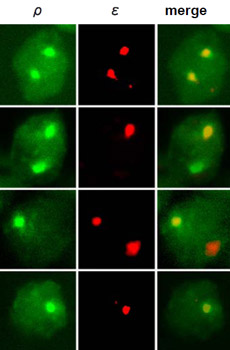| RIKEN Center for Developmental Biology (CDB) 2-2-3 Minatojima minamimachi, Chuo-ku, Kobe 650-0047, Japan |
Nagai and Sheng began by using in situ hybridization to assess whether both, one or neither of the copies of the ρ and ε globins were transcriptionally active in the primitive blood cells of a stage 10 chicken embryo, and found that both loci of a given beta globin gene in any given nucleus tended to make similar decisions regarding transcription. This then raised the question of how the two genes are transcribed in relation to each other at this stage of development. The results of double FISH analyses using ρ(+/-) and ε(+/-) nuclei revealed not only that these genes overwhelmingly tend to be co-transcribed, but that this co-transcription is cooperative: of all loci in which at least one signal was detected for either ρ or ε, more than 80% were positive for both. “We think this shows quite clearly that the majority of loci are concurrently transcribing both rho and epsilon in the embryo,” says Sheng.
The evidence for simultaneous transcription of two beta globin genes in a single locus challenges some long-held views about the nature of beta globin expression, which plays out sequentially with different genes in the same locus preferentially transcribed at different stages in development to meet the changing oxygen demands of the organism. And, as the beta globins have served for decades as a workhorse system for studies of molecular biology and genetics, the implications for our understanding of transcriptional activation may be far-reaching. “For me, this study leads to some interesting questions about when we can truly say a gene has been 'switched on,'” says Sheng. “From what we're seeing here, what people have been calling the on state for a beta globin is really more of a cumulative effect of multiple factors influencing the abundance of transcript and any given time. Of course, that leaves open the question of what is happening when you have an open locus and all the necessary transcription factors to activate a gene? There is probably some key additional step that we don't understand well.”
|
|||||
|
|||||
 |
| Copyright (C) CENTER FOR DEVELOPMENTAL BIOLOGY All rights reserved. |
